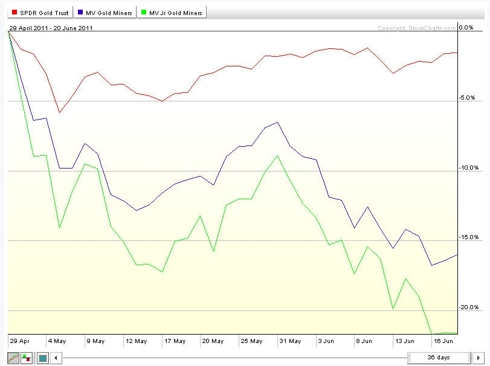 I was reading a couple of Seeking Alpha articles the other day, entitled "Are Gold Miners Set to Explode?" and "Echoes of 2008 Suggest Caution for Precious Metals Investors." This got me to thinking about the relative performance of gold and gold stocks, because before going to graduate school I interned for a summer as a runner on the Chicago Mercantile Exchange. There I was thrown into the world of trading and introduced to the numerous rules about trading.
I was reading a couple of Seeking Alpha articles the other day, entitled "Are Gold Miners Set to Explode?" and "Echoes of 2008 Suggest Caution for Precious Metals Investors." This got me to thinking about the relative performance of gold and gold stocks, because before going to graduate school I interned for a summer as a runner on the Chicago Mercantile Exchange. There I was thrown into the world of trading and introduced to the numerous rules about trading. Among well known: trade with the trend, cut losses, let profits run, etc ... rules, there was, always go long the strongest performing contract in a complex. Such as buying corn in the grain complex if it was up the most compared to soybeans and wheat.
You get on that horse and ride it until the trend is over!
One can transition this thinking into gold bullion vs. gold stocks since recently, gold bullion (gld) has outperformed gold stocks (gdx-majors gdxj-minors) since late April when the silver market peaked.
Obviously gold stock investors believe that the gold price has stagnated or peaked. Throw in correlation and tatical asset allocation trading and the movement in gold stocks, as represented by the indexes, are down -16% GDX and -21.5% GDXJ compared to -1.5% GLD from April 29 to June 20, 2011.
During this time I have been long gold stocks primarily through options, without leverage, so the beating was not as bad, but still hurt! (example of cutting losses).
Now if the bears are correct about the price of gold, then a roll over most likely would bring gold stocks down with it. However, if the gold bull market is intact, and just resting, then GLD has shown itself the strongest of the complex.
The thought that gold miners are "undervalued" based on a stable gold price is tempting. However, I keep two things in mind on the minus side of the pro/con list.
First, gold mines can be confiscated by unfriendly governments much easier than gold (I don't want to get into order 6102 discussion here). Second, one reason to own gold is to hedge against inflation, and with this in mind, inflation causes problems as shown in this article "Fear the Boom, Not the Bust."
"Avoid those industries that are most capital intensive, because in an inflationary environment government taxes phony profits. Much capital investment was expended years ago at lower replacement prices, but the tax man does not recognize replacement cost, only historical cost. So capital-intensive industries report higher profits due to low, historical depreciation expense. In effect, they are being taxed on their capital and cannot retain enough earnings to replace their worn-out plant and equipment. America's so-called Rust Belt of the '70s and '80s can be attributed to the inflation that was begun in the '60s. Now it is coming back."
Mining is very capital intensive.
I have come to the conclusion through reading, research and writing that going long gold bullion appears to be the best way to proceed with a position in the precious metal sector; if one still adheres to the hypothesis that a gold bull market is still underway. I will do some selective stock picking of gold mining stocks but buying the whole gold stock index for an investment seems inferior. I will most likely use gold call options and bull call spreads with options, just in case the gold bears are right. This does produce inferior results compared to outright longs but one is much less concerned about forced liquidation contagion, as happened in 2008 with gold and gold stocks; there is always enough dry powder left to take advantage of fire sale prices.
Disclosure: I am long RBY. Gold, gold stocks, gold stock options




